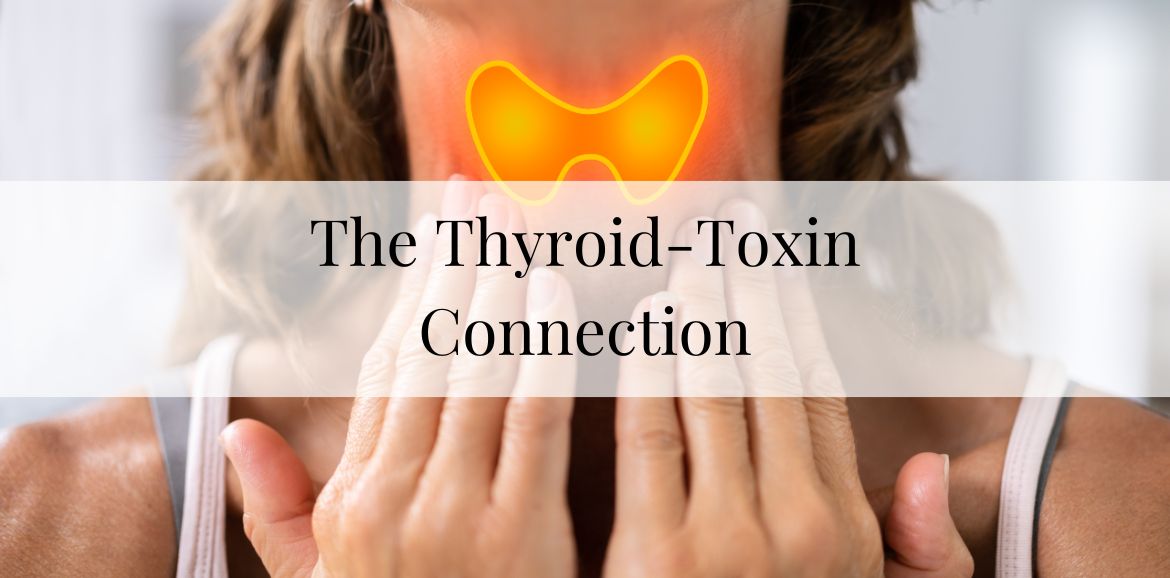If you’ve been told your thyroid is “normal” but you still feel tired, puffy, bloated, foggy, or off in ways you can’t quite explain — you’re not imagining it.
Thyroid dysfunction has become one of the most common yet misunderstood conditions of our time. And while medication and lab results are part of the picture, they’re not the full story.
What many women don’t realize is that your thyroid doesn’t operate in isolation — it’s deeply connected to your liver, gut, detox pathways, and environment. When toxins build up in the body faster than you can clear them, your thyroid often becomes one of the first organs to suffer.
Let’s unpack how environmental toxins disrupt thyroid hormone balance, the advanced lab testing that reveals hidden burdens, and the simple daily shifts that can help you heal naturally.
1. How Environmental Toxins Disrupt Thyroid Hormone Balance
Your thyroid is the body’s metabolic engine — regulating temperature, energy, mood, and metabolism in every cell. But it’s also highly sensitive to environmental chemicals, heavy metals, and endocrine disruptors that interfere with how thyroid hormones are made, converted, and delivered.
Here’s how this happens behind the scenes:
Competing for Nutrients and Receptors
Toxins like fluoride, bromide, and chlorine compete with iodine, the key mineral your thyroid uses to make hormones. This “nutrient hijacking” leads to suboptimal T4 and T3 production even when your iodine intake is adequate.
Conversion Problems
Roughly 20% of thyroid hormone conversion happens in the liver — the rest in the gut. When either is burdened by pesticides, plastics, or heavy metals, your body struggles to convert inactive T4 into active T3, leaving you tired, cold, and foggy-headed.
Hormone Mimicry
Certain toxins (especially BPA, phthalates, and PCBs) mimic thyroid hormones at the cellular level, confusing your body’s feedback loop. The result? You might produce hormones, but your cells can’t “hear” them properly.
Receptor Resistance and Inflammation
Chronic exposure to low-level toxins triggers systemic inflammation and receptor resistance. Even if your labs look “normal,” your cells may be resistant to hormone signaling — a phenomenon much like insulin resistance.
The takeaway: your thyroid may not be “lazy” — it’s often overworked and under-supported.
2. Unconventional Lab Tests That Reveal Hidden Toxic Burdens
Traditional labs provide valuable information — but they often miss what’s stored deep in tissues. Functional testing helps uncover the hidden factors that keep women feeling “stuck” despite doing all the right things.
Here are the key functional labs that provide a deeper look:
1. Urine Heavy Metal Testing
Reveals hidden accumulation of mercury, lead, arsenic, and aluminum that interfere with thyroid enzymes and block hormone receptor sites.
Clues: Fatigue, anxiety, infertility, brain fog, and slow metabolism.
2. Mycotoxin Urine Test
Detects mold toxins from water-damaged environments that can suppress thyroid and adrenal function.
Clues: Hormone swings, histamine issues, anxiety, or “mystery” fatigue.
3. Environmental Toxin Profile (e.g., GPL-TOX, Vibrant Wellness)
Screens for plastics, pesticides, parabens, and solvents that alter hormone metabolism.
Clues: PMS, estrogen dominance, stubborn weight gain, or thyroid antibodies.
4. Glyphosate Test
Glyphosate (the main chemical in Roundup) disrupts the microbiome, damages the gut barrier, and depletes minerals essential for thyroid health.
Clues: Leaky gut, bloating, autoimmune flares, or low nutrient absorption.
5. Fat-Soluble Toxin or Oxidative Stress Panels
Assess the body’s ability to neutralize and excrete persistent fat-stored toxins like dioxins and PCBs.
Clues: Neurological symptoms, mood swings, inflammation, or slow healing.
When interpreted through a functional lens, these labs provide clarity — not fear.
They help you see exactly where your body needs support and how to detox gently, in the right order, without overwhelming your system.
3. Simple Shifts to Minimize Toxins and Their Impact on the Thyroid
You don’t have to overhaul your life to start feeling better. Healing begins with small, consistent actions that reduce your daily toxic burden and strengthen your body’s natural detox pathways.
Start with What You Breathe, Eat, and Drink
- Use a water filter that removes chlorine, fluoride, and heavy metals.
- Store water and leftovers in glass or stainless steel—never plastic.
- Choose organic produce, especially the Dirty Dozen.
- Prioritize grass-fed meats and wild-caught fish to reduce chemical exposure.
- Replace non-stick cookware with cast iron, ceramic, or stainless steel.
Detox Your Home and Body
- Swap out synthetic fragrances and chemical cleaners for natural alternatives.
- Choose clean skincare and makeup — your skin absorbs up to 60% of what you apply.
- Open windows daily, use houseplants, or invest in an air purifier to reduce indoor toxins.
- Sweat intentionally through movement, sauna use, or Epsom salt baths.
Support Your Liver, Gut, and Lymph
- Eat cruciferous vegetables (broccoli, cauliflower, kale) to help the liver detoxify estrogen and toxins.
- Stay hydrated and include fiber daily to bind and remove toxins through the stool.
- Use dry brushing or gentle movement to keep lymph flowing.
- Add liver-supportive nutrients like selenium, zinc, and glycine to promote T4 to T3 conversion.
Protect the Thyroid Directly
- Limit fluoride exposure (especially from water and toothpaste).
- Include foods rich in iodine, selenium, and zinc for thyroid hormone production.
- Avoid extreme fasting or over-exercising—both can suppress thyroid function under stress.
4. The Mindset of Healing: Gentle, Not Extreme
In the age of “detox teas” and viral cleanses, it’s easy to believe you need to purge your body to heal.
But the truth is—your body already knows how to detox. It just needs the right environment and nutrients to do its job.
Healing your thyroid is about removing interference, not forcing outcomes.
Start small. Choose consistency over intensity.
Even swapping your water bottle or upgrading your cookware can lower your exposure load and reduce the stress on your thyroid and liver.
5. The Bottom Line: From Overwhelmed to Empowered
Your body is incredibly intelligent. If your thyroid feels “off,” it’s not betraying you—it’s protecting you.
When toxins accumulate and pathways get sluggish, your thyroid slows things down on purpose, to keep you safe.
By listening to these signals, identifying the hidden burdens, and supporting detoxification gently, you can restore the energy, mental clarity, and metabolism you’ve been missing.
Your thyroid doesn’t need more force—it needs more freedom.
If you’re ready to uncover what’s holding your thyroid back and map out a personalized plan for detox and restoration, I’d love to guide you through that process.
👉 Book a complimentary discovery call to explore what your next best step might be.
Let’s help your body do what it was designed to do—heal, balance, and thrive. 🌿








